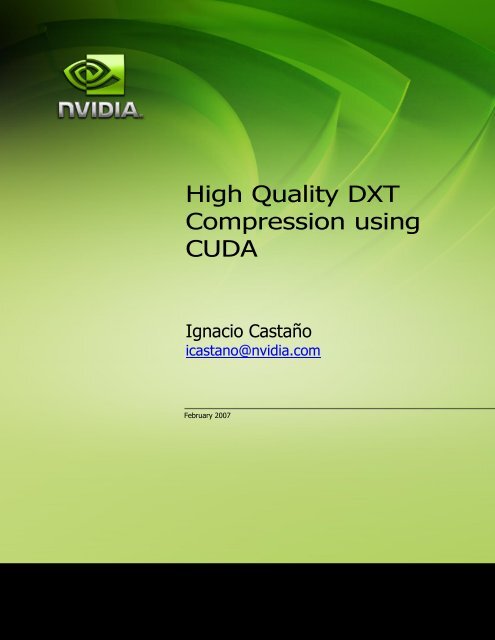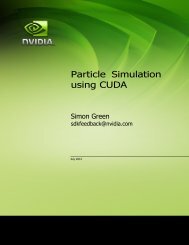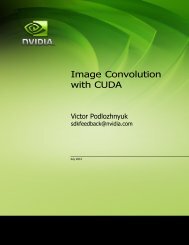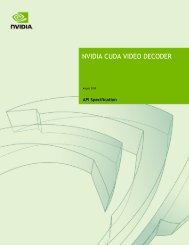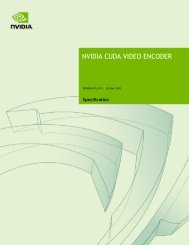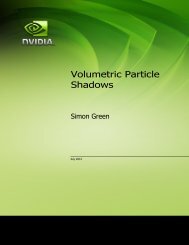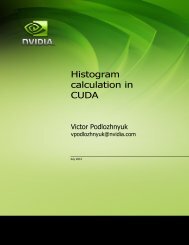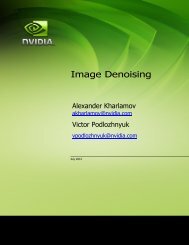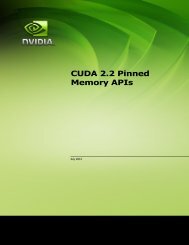High Quality DXT Compression using CUDA
App Note Template - nVIDIA CUDA Toolkit Documentation
App Note Template - nVIDIA CUDA Toolkit Documentation
- No tags were found...
Create successful ePaper yourself
Turn your PDF publications into a flip-book with our unique Google optimized e-Paper software.
<strong>High</strong> <strong>Quality</strong> <strong>DXT</strong><br />
<strong>Compression</strong> <strong>using</strong><br />
<strong>CUDA</strong><br />
Ignacio Castaño<br />
icastano@nvidia.com<br />
February 2007
Document Change History<br />
Version Date Responsible Reason for Change<br />
0.1 02/01/2007 Ignacio Castaño First draft<br />
February 2007<br />
ii
Abstract<br />
<strong>DXT</strong> is a fixed ratio compression format designed for real-time hardware decompression of<br />
textures. While it‟s also possible to encode <strong>DXT</strong> textures in real-time, the quality of the resulting<br />
images is far from the optimal. In this white paper we will overview a more expensive<br />
compression algorithm that produces high quality results and we will see how to implement it<br />
<strong>using</strong> <strong>CUDA</strong> to obtain much higher performance than the equivalent CPU implementation.<br />
Month 2007 1
<strong>High</strong> <strong>Quality</strong> <strong>DXT</strong> <strong>Compression</strong> <strong>using</strong> <strong>CUDA</strong><br />
Motivation<br />
With the increasing number of assets and texture size in recent games, the time required to<br />
process those assets is growing dramatically. <strong>DXT</strong> texture compression takes a large portion of<br />
this time. <strong>High</strong> quality <strong>DXT</strong> compression algorithms are very expensive and while there are<br />
faster alternatives [1][9], the resulting quality of those simplified methods is not very high.<br />
The brute force nature of these compression algorithms makes them suitable to be parallelized<br />
and adapted to the GPU. Cheaper compression algorithms have already been implemented [2]<br />
on the GPU <strong>using</strong> traditional GPGPU approaches. However, with the traditional GPGPU<br />
programming model it‟s not possible to implement more complex algorithms where threads<br />
need to share data and synchronize.<br />
How Does It Work?<br />
In this paper we will see how to use <strong>CUDA</strong> to implement a high quality <strong>DXT</strong>1 texture<br />
compression algorithm in parallel. The algorithm that we have chosen is the cluster fit algorithm<br />
as described by Simon Brown [3]. We will first provide a brief overview of the algorithm and<br />
then we will describe how did we parallelize and implement it in <strong>CUDA</strong>.<br />
<strong>DXT</strong>1 Format<br />
<strong>DXT</strong>1 is a fixed ratio compression scheme that partitions the image into 4x4 blocks. Each<br />
block is encoded with two 16 bit colors in RGB 5-6-5 format and a 4x4 bitmap with 2 bits per<br />
pixel. Figure 1 shows the layout of the block.<br />
Color 0<br />
Color 1<br />
Colors<br />
xx xx xx xx<br />
xx xx xx xx<br />
xx xx xx xx<br />
Bitmap<br />
xx xx xx xx<br />
Figure 1.<br />
<strong>DXT</strong>1 block layout<br />
The block colors are reconstructed by interpolating one or two additional colors between the<br />
given ones and indexing these and the original colors with the bitmap bits. The number of<br />
interpolated colors is chosen depending on whether the value of „Color 0‟ is lower or greater<br />
than „Color 1‟.<br />
February 2007 2
<strong>High</strong> <strong>Quality</strong> <strong>DXT</strong> <strong>Compression</strong> <strong>using</strong> <strong>CUDA</strong><br />
The total size of the block is 64 bits. That means that this scheme achieves a 6:1 compression<br />
ratio. For more details on the <strong>DXT</strong>1 format see the specification of the OpenGL S3TC<br />
extension [4].<br />
Cluster Fit<br />
In general, finding the best two points that minimize the error of a <strong>DXT</strong> encoded block is a<br />
highly discontinuous optimization problem. However, if we assume that the indices of the block<br />
are known the problem becomes a linear optimization problem instead: minimize the distance<br />
from each color of the block to the corresponding color of the palette.<br />
Unfortunately, the indices are not known in advance. We would have to test them all to find<br />
the best solution. Simon Brown [3] suggested pruning the search space by considering only the<br />
indices that preserve the order of the points along the least squares line.<br />
Doing that allows us to reduce the number of indices for which we have to optimize the<br />
endpoints. Simon Brown provided a library [5] that implements this algorithm. We use this<br />
library as a reference to compare the correctness and performance of our <strong>CUDA</strong><br />
implementation.<br />
The next section goes over the implementation details.<br />
<strong>CUDA</strong> Implementation<br />
Partitioning the Problem<br />
We have chosen to use a single thread block to compress each 4x4 color block. Threads that<br />
process a single block need to cooperate with each other, but <strong>DXT</strong> blocks are independent and<br />
do not need synchronization or communication. For this reason our grid size is equal to the<br />
number of blocks in the image.<br />
We also parameterize the problem so that we can change the number of threads per block to<br />
determine what configuration provides better performance. For now, we will just say that the<br />
number of threads is n and later we will discuss what the best configuration is.<br />
During the first part of the algorithm, only 16 threads out of n are active. These threads start<br />
reading the input colors and loading them to shared memory.<br />
Finding the best fit line<br />
To find a line that best approximates a set of points is a well known regression problem. The<br />
colors of the block form a cloud of points in 3D space. This can be solved by computing the<br />
largest eigenvector of the covariance matrix. This vector gives us the direction of the line.<br />
Each element of the covariance matrix is just the sum of the products of different color<br />
components. We implement these sums <strong>using</strong> parallel reductions.<br />
Once we have the covariance matrix we just need to compute its first eigenvector. We haven‟t<br />
found an efficient way of doing this step in parallel. Instead, we use a very cheap sequential<br />
method that doesn‟t add much to the overall execution time of the block.<br />
February 2007 3
<strong>High</strong> <strong>Quality</strong> <strong>DXT</strong> <strong>Compression</strong> <strong>using</strong> <strong>CUDA</strong><br />
Since we only need the dominant eigenvector, we can compute it directly <strong>using</strong> the Power<br />
Method [6]. This method is an iterative method that returns the largest eigenvector and only<br />
requires a single matrix vector product per iteration. Our tests indicate that in most cases 8<br />
iterations are more than enough to obtain an accurate result.<br />
Once we have the direction of the best fit line we project the colors onto it and sort them<br />
along the line <strong>using</strong> brute force parallel sort. This is achieved by comparing all the elements<br />
against each other as follows:<br />
cmp[tid] = (values[0] < values[tid]);<br />
cmp[tid] += (values[1] < values[tid]);<br />
cmp[tid] += (values[2] < values[tid]);<br />
cmp[tid] += (values[3] < values[tid]);<br />
cmp[tid] += (values[4] < values[tid]);<br />
cmp[tid] += (values[5] < values[tid]);<br />
cmp[tid] += (values[6] < values[tid]);<br />
cmp[tid] += (values[7] < values[tid]);<br />
cmp[tid] += (values[8] < values[tid]);<br />
cmp[tid] += (values[9] < values[tid]);<br />
cmp[tid] += (values[10] < values[tid]);<br />
cmp[tid] += (values[11] < values[tid]);<br />
cmp[tid] += (values[12] < values[tid]);<br />
cmp[tid] += (values[13] < values[tid]);<br />
cmp[tid] += (values[14] < values[tid]);<br />
cmp[tid] += (values[15] < values[tid]);<br />
The result of this search is an index array that references the sorted values. However, this<br />
algorithm has a flaw, if two colors are equal or are projected to the same location of the line, the<br />
indices of these two colors will end up with the same value. We solve this problem comparing all<br />
the indices against each other and incrementing one of them if they are equal:<br />
if (tid > 0 && cmp[tid] == cmp[0]) ++cmp[tid];<br />
if (tid > 1 && cmp[tid] == cmp[1]) ++cmp[tid];<br />
if (tid > 2 && cmp[tid] == cmp[2]) ++cmp[tid];<br />
if (tid > 3 && cmp[tid] == cmp[3]) ++cmp[tid];<br />
if (tid > 4 && cmp[tid] == cmp[4]) ++cmp[tid];<br />
if (tid > 5 && cmp[tid] == cmp[5]) ++cmp[tid];<br />
if (tid > 6 && cmp[tid] == cmp[6]) ++cmp[tid];<br />
if (tid > 7 && cmp[tid] == cmp[7]) ++cmp[tid];<br />
if (tid > 8 && cmp[tid] == cmp[8]) ++cmp[tid];<br />
if (tid > 9 && cmp[tid] == cmp[9]) ++cmp[tid];<br />
if (tid > 10 && cmp[tid] == cmp[10]) ++cmp[tid];<br />
if (tid > 11 && cmp[tid] == cmp[11]) ++cmp[tid];<br />
if (tid > 12 && cmp[tid] == cmp[12]) ++cmp[tid];<br />
if (tid > 13 && cmp[tid] == cmp[13]) ++cmp[tid];<br />
if (tid > 14 && cmp[tid] == cmp[14]) ++cmp[tid];<br />
During all these steps only 16 threads are being used. For this reason, it‟s not necessary to<br />
synchronize them. All computations are done in parallel and at the same time step, because 16 is<br />
less than the warp size.<br />
Index evaluation<br />
All the possible ways in which colors can be clustered while preserving the order on the line<br />
are known in advance and for each clustering there‟s a corresponding index. For 4 clusters there<br />
are 975 indices that need to be tested, while for 3 clusters there are only 151. We precompute<br />
these indices and store them in global memory.<br />
February 2007 4
<strong>High</strong> <strong>Quality</strong> <strong>DXT</strong> <strong>Compression</strong> <strong>using</strong> <strong>CUDA</strong><br />
We have to test all these indices and determine which one produces the lowest error. In<br />
general there are more threads than indices. So, we partition the total number of indices by the<br />
number of threads and each thread loops over the set of indices assigned to it.<br />
It‟s tempting to store the indices in constant memory, but since indices are used only once for<br />
each block, and since each thread access a different element, coalesced global memory loads<br />
perform better than constant loads.<br />
Solving the Least Squares Problem<br />
For each index we have to solve an optimization problem. We have to find the two end points<br />
that produce the lowest error. For each input color we know what index it‟s assigned to it, so we<br />
have 16 equations like this:<br />
a b x<br />
i<br />
i<br />
i<br />
Where i<br />
i<br />
,0 3,2 3 2,1 2 3,1 3 0 ,1 depending on the<br />
index and the interpolation mode. We look for the colors a and b that minimize the least<br />
square error of these equations. The solution of that least squares problem is the following:<br />
, are 1 , 1 , 1 , 2 or <br />
2<br />
a<br />
<br />
<br />
i<br />
b<br />
ii<br />
<br />
ii<br />
<br />
2<br />
<br />
i <br />
1<br />
i<br />
xi<br />
<br />
<br />
<br />
<br />
<br />
i<br />
xi<br />
<br />
Note: The matrix inverse is constant for each index set, but it’s cheaper to compute it every<br />
time on the kernel than to load it from global memory. That’s not the case of the CPU<br />
implementation.<br />
Computing the Error<br />
Once we have a potential solution we have to compute its error. However, colors aren‟t stored<br />
with full precision in the <strong>DXT</strong> block, so we have to quantize them to 5-6-5 to estimate the error<br />
accurately. In addition to that, we also have to take in mind that the hardware expands the<br />
quantized color components to 8 bits replicating the highest bits on the lower part of the byte as<br />
follows:<br />
R = (R > 2);<br />
G = (G > 4);<br />
B = (B > 2);<br />
Converting the floating point colors to integers, clamping, bit expanding and converting them<br />
back to float can be time consuming. Instead of that, we clamp the color components <strong>using</strong><br />
floating point saturation, round the floats to integers <strong>using</strong> rintf [8] and approximate the bit<br />
expansion <strong>using</strong> a multiplication. We found the factors that produce the lowest error <strong>using</strong> an<br />
offline optimization that minimized the average error.<br />
r = rintf(__saturatef(r) * 31.0f);<br />
g = rintf(__saturatef(g) * 63.0f);<br />
b = rintf(__saturatef(b) * 31.0f);<br />
r *= 0.03227752766457f;<br />
g *= 0.01583151765563f;<br />
b *= 0.03227752766457f;<br />
Our experiment show that in most cases the approximation produces the same solution as the<br />
accurate solution.<br />
February 2007 5
<strong>High</strong> <strong>Quality</strong> <strong>DXT</strong> <strong>Compression</strong> <strong>using</strong> <strong>CUDA</strong><br />
Selecting the Best Solution<br />
Finally, each thread has evaluated the error of a few indices and has a candidate solution. To<br />
determine which thread has the solution that produces the lowest error, we store the errors in<br />
shared memory and use a parallel reduction to find the minimum. The winning thread writes the<br />
endpoints and indices of the <strong>DXT</strong> block back to global memory.<br />
February 2007 6
<strong>High</strong> <strong>Quality</strong> <strong>DXT</strong> <strong>Compression</strong> <strong>using</strong> <strong>CUDA</strong><br />
Implementation Details<br />
The source code is divided into the following files:<br />
<br />
<br />
<br />
dxtc.cu: This file contains the implementation of the algorithm described here.<br />
CudaMath.h: This file contains some math utilities and the line fitting code.<br />
permutations.h: This file contains the code used to precompute the indices.<br />
dds.h: This file contains the DDS file header definition.<br />
Performance<br />
We have measured the performance of the algorithm on different GPUs and CPUs<br />
compressing the standard Lena. The design of the algorithm makes it insensitive to the actual<br />
content of the image. So, the performance depends only on the size of the image.<br />
Figure 2.<br />
Standard picture used for our tests.<br />
As shown in Table 1, the GPU compressor is at least 10x faster than our best CPU<br />
implementation. The version of the compressor that runs on the CPU uses a SSE2 optimized<br />
implementation of the cluster fit algorithm. This implementation precomputes the factors that<br />
are necessary to solve the least squares problem, while the GPU implementation computes them<br />
on the fly. Without this CPU optimization the difference between the CPU and GPU version is<br />
even larger.<br />
February 2007 7
<strong>High</strong> <strong>Quality</strong> <strong>DXT</strong> <strong>Compression</strong> <strong>using</strong> <strong>CUDA</strong><br />
Table 1.<br />
Image<br />
Lena<br />
512x512<br />
Performance Results<br />
GeForce<br />
8800 GTX<br />
GeForce<br />
8800 GTS<br />
GeForce<br />
8600<br />
Intel Core<br />
2 X6800<br />
AMD Athlon64<br />
Dual Core 4400<br />
54.66 ms 72.88 ms 186.84 ms 563.0 ms 1,251.0 ms<br />
We also experimented with different number of threads, and as indicated in Table 2 we found<br />
out that it performed better with the minimum number of threads.<br />
Table 2.<br />
Thread Number<br />
64 128 256<br />
54.66 ms 56.47 ms 68.13 ms<br />
The reason why the algorithm runs faster with a low number of threads is because during the<br />
first and last sections of the code only a small subset of threads is active. That causes most of<br />
warps to remain idle waiting for these computations to finish. This is reflected by the profiler<br />
that indicates that the occupancy of the hardware during the kernel execution is only 0.33.<br />
A future improvement would be to reorganize the code to eliminate or minimize these stages<br />
of the algorithm. This could be achieved by loading multiple color blocks and processing them in<br />
parallel inside of the same thread block.<br />
Conclusion<br />
We have shown how it is possible to use <strong>CUDA</strong> to implement an existing CPU algorithm in<br />
parallel on the GPU, and obtain an order of magnitude performance improvement. We hope this<br />
will encourage developers to attempt to accelerate other computationally-intensive offline<br />
processing <strong>using</strong> the GPU.<br />
February 2007 8
<strong>High</strong> <strong>Quality</strong> <strong>DXT</strong> <strong>Compression</strong> <strong>using</strong> <strong>CUDA</strong><br />
References<br />
[1] “Real-Time <strong>DXT</strong> <strong>Compression</strong>”, J.M.P. van Waveren.<br />
www.intel.com/cd/ids/developer/asmo-na/eng/324337.htm<br />
[2] “Compressing Dynamically Generated Textures on the GPU”, Oskar Alexandersson,<br />
Christoffer Gurell, Tomas Akenine-Möller.<br />
http://graphics.cs.lth.se/research/papers/gputc2006/<br />
[3] “<strong>DXT</strong> <strong>Compression</strong> Techniques”, Simon Brown.<br />
http://www.sjbrown.co.uk/?article=dxt<br />
[4] “OpenGL S3TC extension spec”, Pat Brown.<br />
http://www.opengl.org/registry/specs/EXT/texture_compression_s3tc.txt<br />
[5] “Squish – <strong>DXT</strong> <strong>Compression</strong> Library”, Simon Brown.<br />
http://www.sjbrown.co.uk/?code=squish<br />
[6] “Eigenvalues and Eigenvectors”, Dr. E. Garcia.<br />
http://www.miislita.com/information-retrieval-tutorial/matrix-tutorial-3-eigenvalueseigenvectors.html<br />
[7] “An Experimental Analysis of Parallel Sorting Algorithms”, Guy E. Blelloch, C. Greg<br />
Plaxton, Charles E. Leiserson, Stephen J. Smith<br />
http://citeseer.ist.psu.edu/blelloch98experimental.html<br />
[8] “NVIDIA <strong>CUDA</strong> Compute Unified Device Architecture Programming Guide”.<br />
[9] NVIDIA OpenGL SDK 10 “Compress <strong>DXT</strong>” sample<br />
http://developer.download.nvidia.com/SDK/10/opengl/samples.html#compress_<strong>DXT</strong><br />
February 2007 9
Notice<br />
ALL NVIDIA DESIGN SPECIFICATIONS, REFERENCE BOARDS, FILES, DRAWINGS, DIAGNOSTICS, LISTS, AND<br />
OTHER DOCUMENTS (TOGETHER AND SEPARATELY, “MATERIALS”) ARE BEING PROVIDED “AS IS.” NVIDIA<br />
MAKES NO WARRANTIES, EXPRESSED, IMPLIED, STATUTORY, OR OTHERWISE WITH RESPECT TO THE<br />
MATERIALS, AND EXPRESSLY DISCLAIMS ALL IMPLIED WARRANTIES OF NONINFRINGEMENT,<br />
MERCHANTABILITY, AND FITNESS FOR A PARTICULAR PURPOSE.<br />
Information furnished is believed to be accurate and reliable. However, NVIDIA Corporation assumes no<br />
responsibility for the consequences of use of such information or for any infringement of patents or other<br />
rights of third parties that may result from its use. No license is granted by implication or otherwise under any<br />
patent or patent rights of NVIDIA Corporation. Specifications mentioned in this publication are subject to<br />
change without notice. This publication supersedes and replaces all information previously supplied. NVIDIA<br />
Corporation products are not authorized for use as critical components in life support devices or systems<br />
without express written approval of NVIDIA Corporation.<br />
Trademarks<br />
NVIDIA, the NVIDIA logo, GeForce, and NVIDIA Quadro are trademarks or registered<br />
trademarks of NVIDIA Corporation in the United States and other countries. Other company and<br />
product names may be trademarks of the respective companies with which they are associated.<br />
Copyright<br />
© 2007-2012 NVIDIA Corporation. All rights reserved.<br />
NVIDIA Corporation<br />
2701 San Tomas Expressway<br />
Santa Clara, CA 95050<br />
www.nvidia.com


